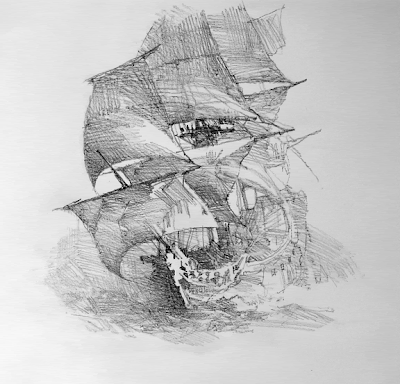 John Smith was born in Cathness in Northern Scotland, but
had been raised by relations in Carisston in the Orkneys. On
reaching
maturity he sailed on several ships until signing on as mate on
the George
Galley, formerly known as the Princess Carolina. The ship sailed
for
Sancta Cruz on the Barbary Coast. Having been scrimped on by the
peevish
captain Ferneau during the month long trip, Smith and James
Williams
conspired to take the ship and turn to piracy. During the return
trip from
Sancta Cruz, Smith and his confederates seized the ship, killing
all the
officers that stood in their way.
John Smith was born in Cathness in Northern Scotland, but
had been raised by relations in Carisston in the Orkneys. On
reaching
maturity he sailed on several ships until signing on as mate on
the George
Galley, formerly known as the Princess Carolina. The ship sailed
for
Sancta Cruz on the Barbary Coast. Having been scrimped on by the
peevish
captain Ferneau during the month long trip, Smith and James
Williams
conspired to take the ship and turn to piracy. During the return
trip from
Sancta Cruz, Smith and his confederates seized the ship, killing
all the
officers that stood in their way.After some refit and renaming the ship as the Revenge, the crew fell to the trade of pirating. Crossing paths with the Delight and the Bachelor, ships bound from Newfoundland to Cadiz, on November 18 and December 18 respectively, the pirates plundered them of all of value and sank them to prevent any news of their work. From the Coast of the Southward Cape to Cape Finisterre they took a Scottish snow and French ship bound from Cadiz to Brest.
Their next victim was the Triumvirate within thirty leagues of Vigo. The next ship was a French ship of some means that upon approach fired on the pirates rather than surrender. Smith made to stand off form the ship; Williams provoked by this fired a pistol at Smith's head and castigated him for cowardice and upbraided him for passing up a ship that would have had plenty of plunder. The crew, however, approved of Smith's actions and put Williams into the Triumvirate with all the prisoners of earlier raids and set them free. Williams was surrendered to authorities on an English ship in Lisbon, commanded by a Captain Davis. At this time the Ludlow Castle, an English warship was set out to search for the pirates, but after fifteen days gave up the search and returned to Lisbon.
Thinking that things might be getting too hot for them in the area, the pirates set sail for the Orkneys to careen and refit their ship. Here several of the crew who had been pressed into service, made off with a longboat and appraised the authorities of the identities of this ship's crew. Attempting to escape Smith set the ship to rights and making little headway, the wind turned them into shore and grounded the ship off Calf Sound. The pirates were captured and transported to England for trial. Smith refused to plead guilty or not for the court and was punished for this stubbornness. He was hanged on June 11, 1725.
The best of pirates may have had years of success before reaching Smith's demise, but not most. Many would have had short runs like Smith, due to a lack of luck, experience or intelligence. Smith seems to have suffered from two if not all of these shortcomings.










